Abstract
Extensive screening of aromatase cDNA was carried out in cDNA libraries from various human tissues. The DNA sequences of all the isolated cDNA clones were identical in the region encoded by exons 2-10 of the aromatase gene. However, tissue-specific sequences, which were classified into four groups, were observed in the 5' portions of the clones corresponding to the region encoded by exon 1. All of them were also found in clones isolated from a human genomic library and mapped between exons 1 and 2 of the human aromatase gene reported previously, suggesting the presence of multiple exons 1 and promoters in the gene. Reverse transcription-PCR analyses of aromatase mRNAs in various tissues revealed that aromatase transcripts are tissue-specifically spliced by alternative use of multiple exons 1, although minor forms of the transcripts were also present in each tissue. Aromatase mRNA is spliced from 10 exons in most tissues, but from 9 exons in the prostate and from 10 or 11 exons in the placenta. This suggests that tissue-specific regulation of the aromatase gene in various tissues may be explained by alternative use of multiple exons 1 flanked with tissue-specific promoters. The alternative use of multiple exons 1 for liver transcripts was found to change developmentally. Furthermore, switch from an adipose-specific exon 1 to another type of exon 1 was observed in aromatase transcripts of adipose tissues of three of five breast cancer patients.
Full text
PDF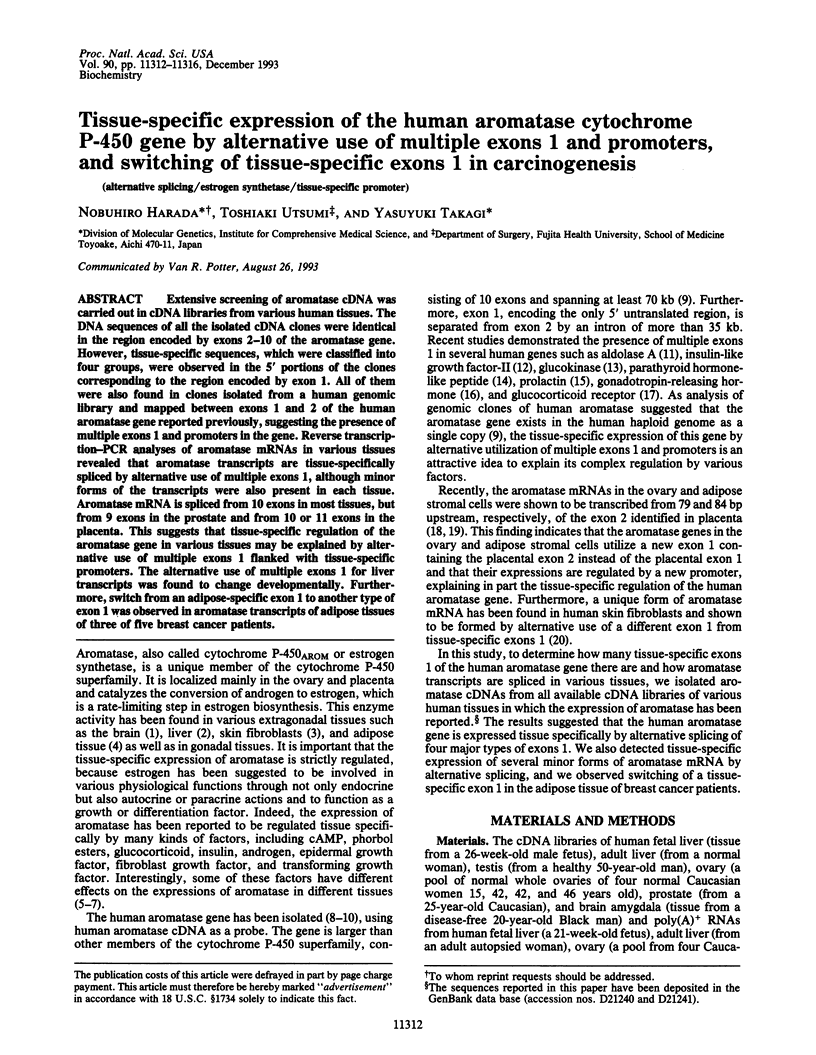
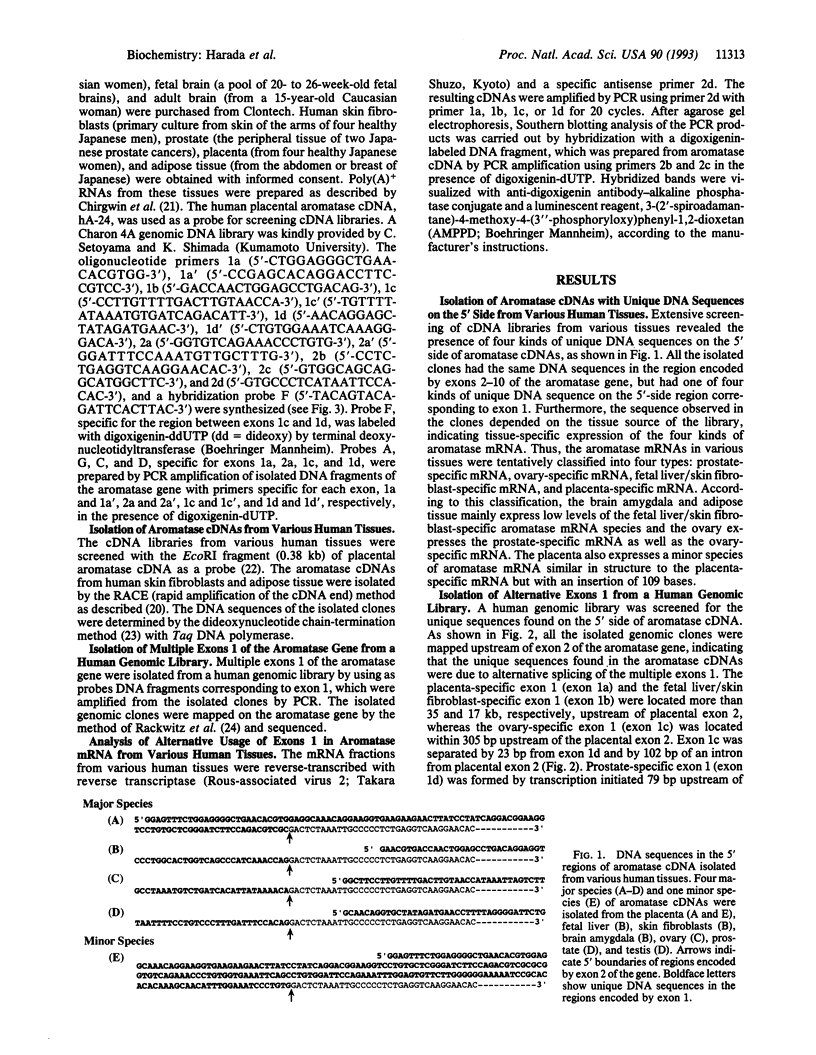
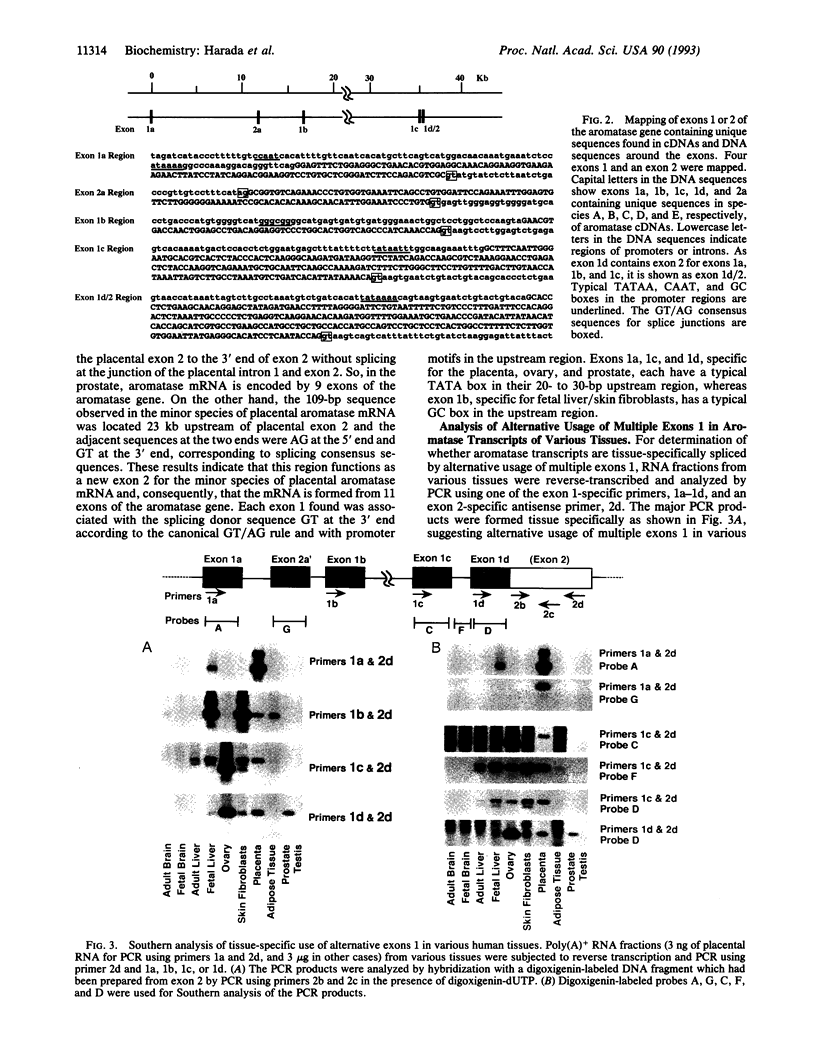
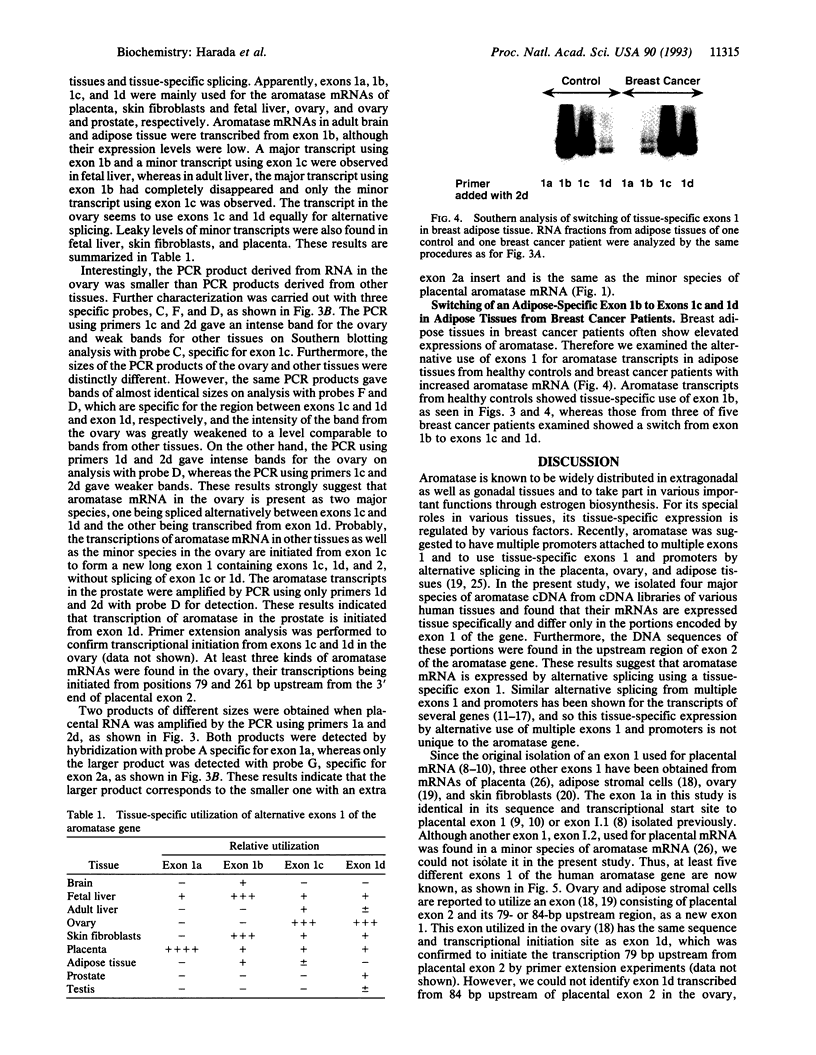
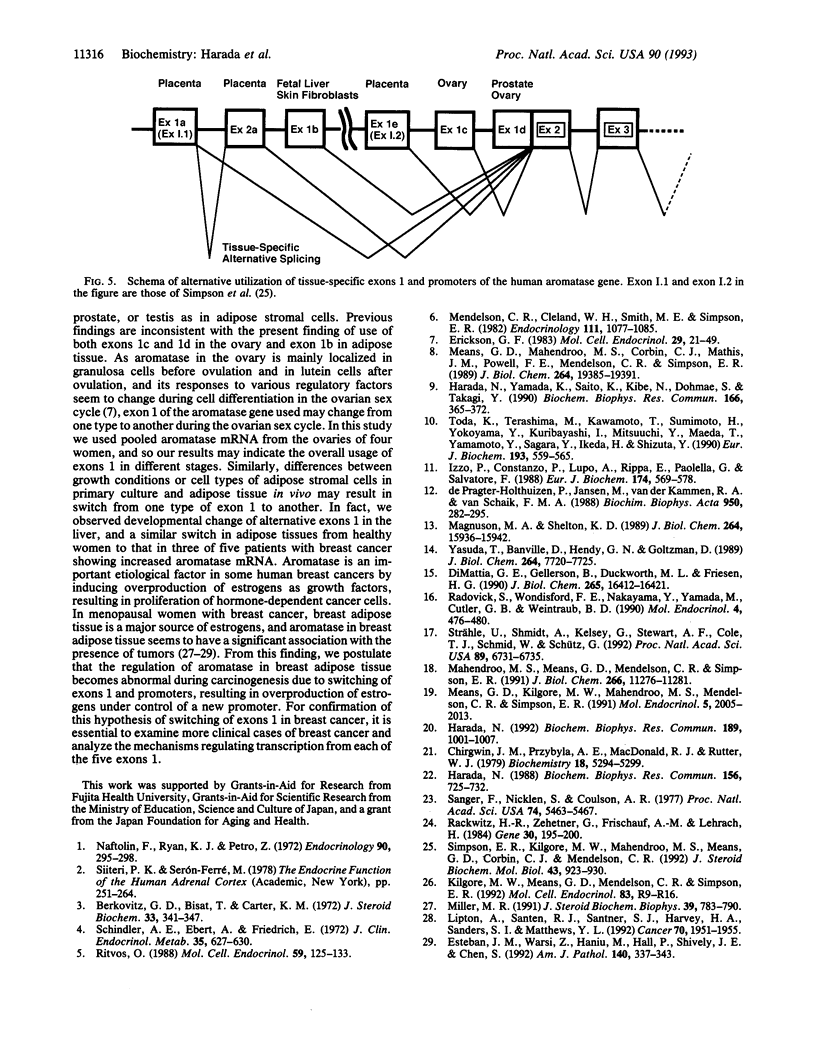
Images in this article
Selected References
These references are in PubMed. This may not be the complete list of references from this article.
- Berkovitz G. D., Bisat T., Carter K. M. Aromatase activity in microsomal preparations of human genital skin fibroblasts: influence of glucocorticoids. J Steroid Biochem. 1989 Sep;33(3):341–347. doi: 10.1016/0022-4731(89)90322-1. [DOI] [PubMed] [Google Scholar]
- Chirgwin J. M., Przybyla A. E., MacDonald R. J., Rutter W. J. Isolation of biologically active ribonucleic acid from sources enriched in ribonuclease. Biochemistry. 1979 Nov 27;18(24):5294–5299. doi: 10.1021/bi00591a005. [DOI] [PubMed] [Google Scholar]
- DiMattia G. E., Gellersen B., Duckworth M. L., Friesen H. G. Human prolactin gene expression. The use of an alternative noncoding exon in decidua and the IM-9-P3 lymphoblast cell line. J Biol Chem. 1990 Sep 25;265(27):16412–16421. [PubMed] [Google Scholar]
- Erickson G. F. Primary cultures of ovarian cells in serum-free medium as models of hormone-dependent differentiation. Mol Cell Endocrinol. 1983 Jan;29(1):21–49. doi: 10.1016/0303-7207(83)90003-5. [DOI] [PubMed] [Google Scholar]
- Esteban J. M., Warsi Z., Haniu M., Hall P., Shively J. E., Chen S. Detection of intratumoral aromatase in breast carcinomas. An immunohistochemical study with clinicopathologic correlation. Am J Pathol. 1992 Feb;140(2):337–343. [PMC free article] [PubMed] [Google Scholar]
- Harada N. A unique aromatase (P-450AROM) mRNA formed by alternative use of tissue-specific exons 1 in human skin fibroblasts. Biochem Biophys Res Commun. 1992 Dec 15;189(2):1001–1007. doi: 10.1016/0006-291x(92)92303-f. [DOI] [PubMed] [Google Scholar]
- Harada N. Cloning of a complete cDNA encoding human aromatase: immunochemical identification and sequence analysis. Biochem Biophys Res Commun. 1988 Oct 31;156(2):725–732. doi: 10.1016/s0006-291x(88)80903-3. [DOI] [PubMed] [Google Scholar]
- Harada N., Yamada K., Saito K., Kibe N., Dohmae S., Takagi Y. Structural characterization of the human estrogen synthetase (aromatase) gene. Biochem Biophys Res Commun. 1990 Jan 15;166(1):365–372. doi: 10.1016/0006-291x(90)91954-q. [DOI] [PubMed] [Google Scholar]
- Izzo P., Costanzo P., Lupo A., Rippa E., Paolella G., Salvatore F. Human aldolase A gene. Structural organization and tissue-specific expression by multiple promoters and alternate mRNA processing. Eur J Biochem. 1988 Jul 1;174(4):569–578. doi: 10.1111/j.1432-1033.1988.tb14136.x. [DOI] [PubMed] [Google Scholar]
- Lipton A., Santen R. J., Santner S. J., Harvey H. A., Sanders S. I., Matthews Y. L. Prognostic value of breast cancer aromatase. Cancer. 1992 Oct 1;70(7):1951–1955. doi: 10.1002/1097-0142(19921001)70:7<1951::aid-cncr2820700723>3.0.co;2-#. [DOI] [PubMed] [Google Scholar]
- Magnuson M. A., Shelton K. D. An alternate promoter in the glucokinase gene is active in the pancreatic beta cell. J Biol Chem. 1989 Sep 25;264(27):15936–15942. [PubMed] [Google Scholar]
- Mahendroo M. S., Means G. D., Mendelson C. R., Simpson E. R. Tissue-specific expression of human P-450AROM. The promoter responsible for expression in adipose tissue is different from that utilized in placenta. J Biol Chem. 1991 Jun 15;266(17):11276–11281. [PubMed] [Google Scholar]
- Means G. D., Kilgore M. W., Mahendroo M. S., Mendelson C. R., Simpson E. R. Tissue-specific promoters regulate aromatase cytochrome P450 gene expression in human ovary and fetal tissues. Mol Endocrinol. 1991 Dec;5(12):2005–2013. doi: 10.1210/mend-5-12-2005. [DOI] [PubMed] [Google Scholar]
- Means G. D., Mahendroo M. S., Corbin C. J., Mathis J. M., Powell F. E., Mendelson C. R., Simpson E. R. Structural analysis of the gene encoding human aromatase cytochrome P-450, the enzyme responsible for estrogen biosynthesis. J Biol Chem. 1989 Nov 15;264(32):19385–19391. [PubMed] [Google Scholar]
- Mendelson C. R., Cleland W. H., Smith M. E., Simpson E. R. Regulation of aromatase activity of stromal cells derived from human adipose tissue. Endocrinology. 1982 Oct;111(4):1077–1085. doi: 10.1210/endo-111-4-1077. [DOI] [PubMed] [Google Scholar]
- Miller W. R. Aromatase activity in breast tissue. J Steroid Biochem Mol Biol. 1991 Nov;39(5B):783–790. doi: 10.1016/0960-0760(91)90026-2. [DOI] [PubMed] [Google Scholar]
- Naftolin F., Ryan K. J., Petro Z. Aromatization of androstenedione by the anterior hypothalamus of adult male and female rats. Endocrinology. 1972 Jan;90(1):295–298. doi: 10.1210/endo-90-1-295. [DOI] [PubMed] [Google Scholar]
- Rackwitz H. R., Zehetner G., Frischauf A. M., Lehrach H. Rapid restriction mapping of DNA cloned in lambda phage vectors. Gene. 1984 Oct;30(1-3):195–200. doi: 10.1016/0378-1119(84)90120-3. [DOI] [PubMed] [Google Scholar]
- Radovick S., Wondisford F. E., Nakayama Y., Yamada M., Cutler G. B., Jr, Weintraub B. D. Isolation and characterization of the human gonadotropin-releasing hormone gene in the hypothalamus and placenta. Mol Endocrinol. 1990 Mar;4(3):476–480. doi: 10.1210/mend-4-3-476. [DOI] [PubMed] [Google Scholar]
- Ritvos O. Modulation of steroidogenesis in choriocarcinoma cells by cholera toxin, phorbol ester, epidermal growth factor and insulin-like growth factor I. Mol Cell Endocrinol. 1988 Sep;59(1-2):125–133. doi: 10.1016/0303-7207(88)90203-1. [DOI] [PubMed] [Google Scholar]
- Sanger F., Nicklen S., Coulson A. R. DNA sequencing with chain-terminating inhibitors. Proc Natl Acad Sci U S A. 1977 Dec;74(12):5463–5467. doi: 10.1073/pnas.74.12.5463. [DOI] [PMC free article] [PubMed] [Google Scholar]
- Schindler A. E., Ebert A., Friedrich E. Conversion of androstenedione to estrone by human tissue. J Clin Endocrinol Metab. 1972 Oct;35(4):627–630. doi: 10.1210/jcem-35-4-627. [DOI] [PubMed] [Google Scholar]
- Strähle U., Schmidt A., Kelsey G., Stewart A. F., Cole T. J., Schmid W., Schütz G. At least three promoters direct expression of the mouse glucocorticoid receptor gene. Proc Natl Acad Sci U S A. 1992 Aug 1;89(15):6731–6735. doi: 10.1073/pnas.89.15.6731. [DOI] [PMC free article] [PubMed] [Google Scholar]
- Toda K., Terashima M., Kawamoto T., Sumimoto H., Yokoyama Y., Kuribayashi I., Mitsuuchi Y., Maeda T., Yamamoto Y., Sagara Y. Structural and functional characterization of human aromatase P-450 gene. Eur J Biochem. 1990 Oct 24;193(2):559–565. doi: 10.1111/j.1432-1033.1990.tb19372.x. [DOI] [PubMed] [Google Scholar]
- Yasuda T., Banville D., Hendy G. N., Goltzman D. Characterization of the human parathyroid hormone-like peptide gene. Functional and evolutionary aspects. J Biol Chem. 1989 May 5;264(13):7720–7725. [PubMed] [Google Scholar]
- de Pagter-Holthuizen P., Jansen M., van der Kammen R. A., van Schaik F. M., Sussenbach J. S. Differential expression of the human insulin-like growth factor II gene. Characterization of the IGF-II mRNAs and an mRNA encoding a putative IGF-II-associated protein. Biochim Biophys Acta. 1988 Sep 7;950(3):282–295. doi: 10.1016/0167-4781(88)90124-8. [DOI] [PubMed] [Google Scholar]




